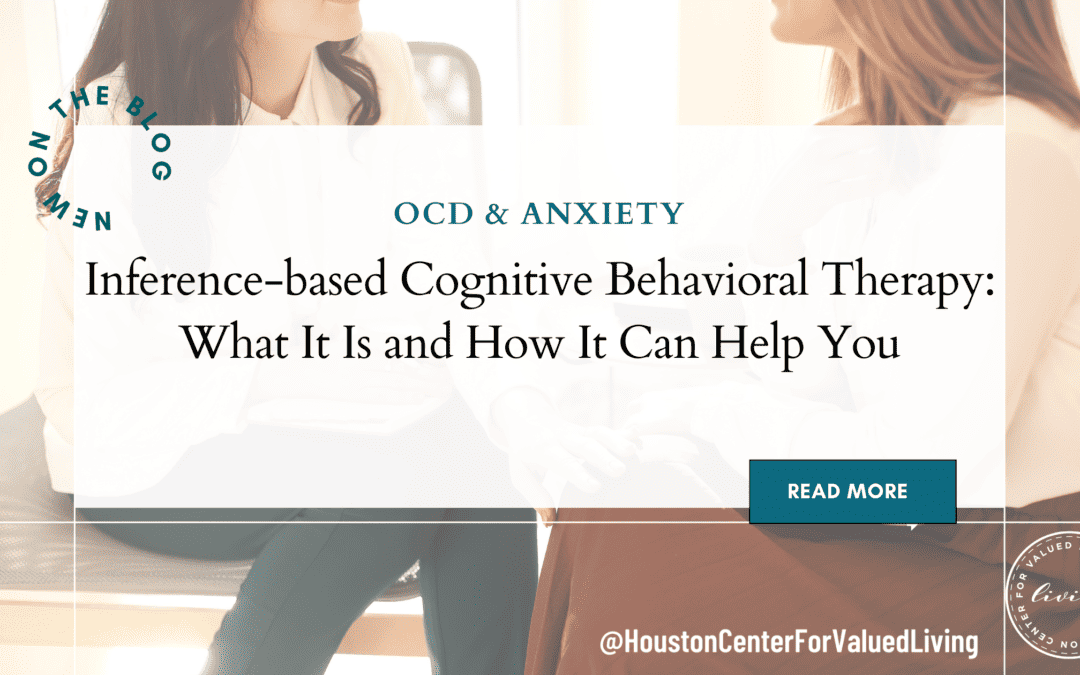What is Inference-Based Cognitive Behavioral Therapy and how could it help you?

Obsessive Compulsive Disorder is one of the most misunderstood mental disorders. In the last decades, great strides have been taken in correctly diagnosing and treating this disorder. However, individuals with OCD still suffer unnecessary every day due to lack of specialized treatment and difficulty accessing mental health services. It is appalling that today it still takes 14-17 years on average for an individual with OCD to find accurate treatment especially since we have so many effective treatments available.
Exposure and Response Prevention (ERP) has been the treatment-of-choice for OCD for many years. ERP involves identifying individual triggers for anxiety, moving towards those triggers deliberately, and then working systematically to decrease compulsive behaviors and avoidance. ERP works well; studies have shown that 60-80% of people respond well to ERP and see a decrease in their OCD symptoms. However, there is a group of people who are unable or unwilling to do ERP and also a whole group of people who do not benefit from ERP.
Inference-based Cognitive Behavioral Therapy (I-CBT) was designated specifically for these individuals. Since mid-90’s I-CBT has been gaining support through research as well as personal experiences and it is today considered to be equally effective as ERP. In fact, many individuals prefer I-CBT over ERP, and many people choose to try I-CBT perhaps after not seeing benefits from ERP. Some individuals might have used ERP successfully for certain OCD-themes but have noticed that it does not work for them with other themes.
Inference-based Cognitive Behavioral Therapy is a cognitive treatment, meaning that it focuses on the thought patterns and processes that underlie OCD. I-CBT is based on the thinking that OCD occurs due to obsessive doubting, which is fueled by a narrative that makes the doubt seem credible. Because the doubt sounds so real and believable, people fall into the trap of compulsively trying to figure out a solution to the doubt. Of course, no solution really exists because the doubt is not based on reality but rather on imagination.
One of the tricks that OCD uses against us is that it makes us doubt our own senses. We all use our five senses constantly to make sense of the world and to make decisions. Individuals with OCD are no different. However, for some reason, when it comes to OCD-triggers, we ignore the sense information that we have and enter the OCD-bubble. In the OCD-bubble we are effectively dissociating from reality and living as if the OCD-narrative is true. We believe in the narrative and disregard the information that our senses are giving us.
Another thing that OCD makes us doubt is our true selves. We all know who we are as people, what our values are, and what kind of life we want to live. However, OCD makes us doubt this as well. OCD wants us to ignore the inner sense data that we have about ourselves and wants to make us believe that we could be, or turn into, someone who is exactly the opposite. This is why a certain theme is triggering for one person but not another. It is because this possibility seems so scary that we will do anything in our power to try to make sure we don’t turn into that feared self.
This is the process that I-CBT has labeled as inferential confusion. In OCD-situations, we get confused about what is reality and what is imagination. Through I-CBT clients learn to trust their five senses as well as their inner sense. Clients are also taught how to identify the cross-over point where they leave reality and enter the OCD-bubble so that they can make a choice and not just automatically do whatever OCD tells them to do. Through I-CBT, the initial doubt is resolved by remaining in the present moment and trusting our senses. Therefore, the obsessive doubt and consequent anxiety go away. There is no need to tolerate uncertainty because we have certainty based on the information our senses are giving us. This is one huge difference between I-CBT and ERP, where tolerating uncertainty is one of the main components of treatment.
Another big difference between ERP and I-CBT is the way they view obsessions. According to ERP, intrusive thoughts are normal random thoughts that occur to everyone. They will turn into obsessions when they are given additional meaning and treated differently than other thoughts. ERP targets the interpretation of these thoughts and helps client no longer react to them in a negative way. I-CBT, on the other hand, believes that obsessions do not start out as random intrusive thoughts but rather occur due to faulty reasoning. It is the reasoning that needs to change to resolve the obsessive doubt.
Exposures can be intimidating especially in the beginning of treatment. Some clients might choose not to engage in exposures because they are deemed as too anxiety-provoking. It can also be difficult to carry out exposures individually in between therapy sessions even if exposures are successful in session. I-CBT does not have a behavioral component, where clients would be asked to enter anxiety-provoking situations. However, it is assumed that as the obsessional doubt gets resolved, behavior will naturally change too and since there is no doubt, compulsions are not necessary.
If you are an individual living with OCD and would like to get more information on I-CBT, give us a call. One of our OCD experts would be happy to meet with you and discuss your treatment options. Together we can move towards a life with more freedom and less anxiety.

At the Houston Center for Valued Living, we offer therapy in Houston for a variety of life’s challenges. Our team of compassionate therapists offer a variety of therapeutic specialties including:
- OCD
- Intensive Treatment for OCD
- Anxiety
- Insomnia
- Depression
- Reproductive Mental Health
- Children
- Parenting
- Adolescents & Teens
- Trauma/PTSD
- Body focused repetitive behaviors

